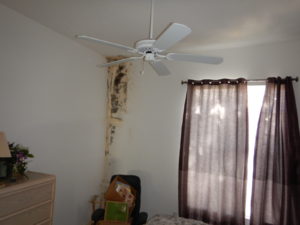How to Identify Toxic Black Mold?
What Does Toxic Black Mold Look Like?
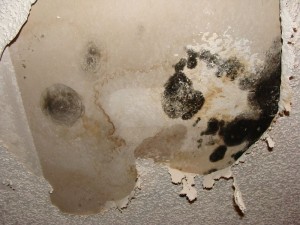
This is a great example of what Stachybotrys or toxic black mold looks like. This was growing behind popcorn ceiling coating at a home we inspected.
A Accredited Mold inspection Service would like to answer some common questions on toxic black mold identification. Also, further down, you will find even more photos of toxic black mold. Most of the images are from our own mold inspections. Toxic black mold is a specific type of black colored mold, it’s scientific name is Stachybotrys Chartarum. Other black molds grow indoors and can be confused with Stachybotrys. It’s common name is toxic black mold or toxic mold because it contains some extremely bad toxins, but will likely not poison you. It typically causes allergy and asthma problems in most people. A knowledge of toxic molds appearance and preferred habitat in the home can help you do at least a preliminary possible identification of this mold. It will not be a guaranteed identification of toxic mold, but it can sometimes give you a start.
What Does Toxic Black Mold Look Like When Growing in My Home?
Colors Before Spore Formation.
Here is a perfect example of a young colony of toxic mold or Stachybotrys just starting to form spores in its older center. As it ages, the spores will spread closer to the edges bringing dark coloration with it. This is how it looks in a petri dish. It is rare to see this type of coloration pattern when Stachybotrys is growing in your home. So why am I talking about it’s early non-spore forming white stage that turns black in the center? The reason is though you may not see it like this in the home, it does occur in the home. Black mold or Stachybotrys is white before it forms spores in the home. But it is often well hidden and by the time you find it growing in your home, the growth has likely already turned dark black.
To see more images of what toxic black mold looks like in a home mold test kit or petri dish visit our page on that subject.
Mature Coloration After Spore Formation
Recognizable Shapes and Patterns in its Growth
Also, the mold often forms concentric circles of one circle inside another circle as shown in the photo. I know of no other mold that grows like this outside of the lab.
In this image we see concentric circles like a bullseye pattern of mold found sometimes in the field is seen of a colony of Stachybotrys grown on paper. Not a common pattern but it happens.
Irregular Shapes and Patterns in it’s Growth
In the home it is often reported to be shiny or slimy in appearance, however, from personal experience, this is only true when the mold is wet. It is wet most of the time because it requires very wet surfaces for growth. If the leak has been fixed the mold dries out and then it looks dry and powdery in appearance.
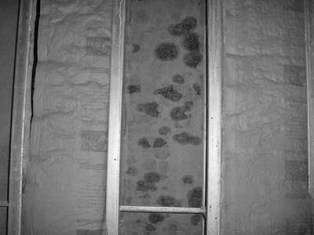
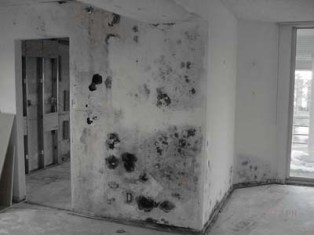
Stachybotrys found by our mold inspector while doing a mold inspection in the Florida Keys.
It was either in Key Largo or Islamorada. This was behind a baseboard in a school’s flooded AC closet.
A cardboard box and some paper on a wet AC closet floor in the same school AC closet in the Keys.
Toxic Molds Preferred Ecological Niche
It is the same with all living organisms including the humble molds.
In the home toxic black mold or Stachybotrys typically grows on soaking wet cellulose rich materials like paper, cardboard, wood, and the paper backing found on drywall. In nature is found on wet hay, dead leaves, and wood.
When it grows on drywall, it is actually growing on the thin cellulose rich paper that coats both surfaces of the drywall.
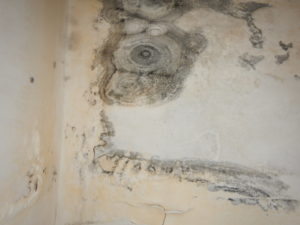
Close up of Toxic Black Mold on the same wall in West Palm Beach Florida. Note the circle in a circle pattern.
Growth Rate of Toxic Black Mold
That is one reason why it is best to utilize non viable sampling methods for this type of molds identification.
When the housing market crashed, I inspected many foreclosed homes. Foreclosed homes that had been empty for about two or three years often had very large amounts of this mold. It seems to crowd out the initial faster growing molds that are eventually replace in many areas by toxic black mold.
Moisture Requirements of Stachybotrys
This type of mold requires more moisture than some other molds.
If you want the find any mold the best way is very often not look for mold only. First find the moisture. If you have moisture for a period of time, (a few days to a few weeks,) then you will likely have mold in your walls or on your walls or behind your baseboards. The way to find moisture is with a moisture meter. They are much more sensitive than your hand at detecting moisture.
Are All Black Molds Toxic Black Mold?
Question: Are all black molds toxic black mold?
Answer: Not all black molds are toxic black mold.
These other black house molds include:
Common Stachybotrys Lookalikes
Memnonellia
This mold is extremely closely related to Stachybotry. It grows in the same habitat as Stachybotrys, it looks like it, it even produces similar toxins. It has similar looking microscopic spores, but the spores are arranged differently on the mold. Difficult to tell from Stachybotrys without microscopic or genetic analysis.
Aspergillius niger
Can be confused with Stachybotrys very easily as it looks a lot like Stachybotrys, and grows in the same severely water damaged cellulose rich habitats as Stachybotrys.
Cladosporium
Can be confused with Stachybotrys as it looks like Stachybotrys, and sometimes grows in the same severely water damaged cellulose rich habitats as Stachybotrys. But quite often grows in low cellulose low nitrogen environments like on metal, plastic, fiberglass, aluminum fences, live tree leaves, concrete. These are places that Stachybotrys do not readily colonize. If you have mold growing on one of the above surfaces it is likely Cladosporium and not Stachybotrys. Cladosporium loves condensation, it grows around window condensation and AC duct and AC register condensation quite often. If you have mold around light condensation it may be Cladosporium.
Nigrospora
I am sure it grows indoors sometimes but only one time I took a sample of mold and analyzed it and found it to be Nirgospora growth. It looks like Stachybotrys to the unaided eye. It was growing on a wet carpet near a window. Sure a few of its spores are commonly found floating in indoor and outdoor air. But as stated it is not typically found growing as a visible mass or colony indoors in my experience.
This is after 17 years of testing mold in home! Thus, if you see black mold colonies growing indoors it is rarely Nigrospora.
The above comments about Nigrospora apply to Alternaria, If I remember correctly, I have found this mold growing as a visible colony about two times in 17 years. It looks like Stachybotrys to the unaided eye. The spores are commonly found floating in indoor and outdoor air but I just have not found much of it growing in the form of visible colonies indoors very much. Thus, is you see black mold indoors it is likely not Alternaria.
Why Do People Call It Toxic Mold?
The Problem with Stachybotrys.
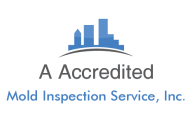 About A Accredited Mold Inspection Service, Inc.
About A Accredited Mold Inspection Service, Inc.
We are certified mold inspectors providing toxic black mold testing for homeowners, renters, and commercial office building managers from West Palm Beach to Miami Florida and beyond including Lake Worth, Ft Lauderdale and more. We also find and diagnose moisture and humidity problems that are the original cause and origin of mold problems.
1-888-381-6651




